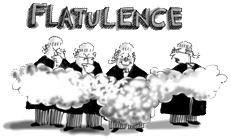WorkCover spies don't add up
 Barry Lane •
Barry Lane •  Friday, August 20, 2010
Friday, August 20, 2010 Secret surveillance of workers claiming compo is about as useful as ASIO spying on the Aarons family ... The WorkCover industry is hooked on spooking ... Barry Lane files from Melbourne  When Mark Arrons, scion of the first family of Australian communism, recently obtained access to ASIO files kept on him and his family, he was presented with a pile of 32,000 documents - 14,000 of which related to his father Laurie.
When Mark Arrons, scion of the first family of Australian communism, recently obtained access to ASIO files kept on him and his family, he was presented with a pile of 32,000 documents - 14,000 of which related to his father Laurie.
The documents detailed snooping on a prodigious scale.
When writing in The Oz on some of that snooping, Aarons referred to records of a meeting between his father, uncle Eric and former Labor Senator Arthur Gietzelt at Eric's flat in Neutral Bay. Aarons wrote:
"ASIO, usually, had advance intelligence of these rendezvous; on one occasion they tailed Gietzelt from his home in Caringbah in southern Sydney to the secret meeting place. ASIO's officers meticulously followed them to these meetings, photographed them, drew maps to illustrate their elaborate precautions to evade scrutiny, and recorded a meeting at Eric's flat in Neutral Bay."
And what was the product of all this surveillance over many decades, which would have cost taxpayers millions of dollars?
Well, Sweet Fanny Adams actually.  Mark Aarons with ASIO's family historyAs Aarons records in his Oz piece:
Mark Aarons with ASIO's family historyAs Aarons records in his Oz piece:
"No evidence was ever found implicating any family member in espionage."
Workers compensation insiders know that surveillance of workers claiming benefits, specially common law damages, is big business.
As far as I'm aware, the VWA does not publish details on how much it spends on surveillance, but my hunch is it would be heaps.
A pal of mine on the County Court says that in his experience most of the surveillance film shown in court, which is usually only a fraction of that taken, is useless.
That doesn't mean to say that it is otherwise valueless as Butcher v Australian Tartaric Products Pty Ltd illustrates.
The video, which is routinely trotted out in "serious injury" cases in the County Court, might be worthless before a judge, but put the same footage before a jury that hasn't seen any of this before and it might be a different ball game.
Justice Ashley detailed the surveillance film in Butcher:
"Between 13 April 2005 and 21 August 2008 the appellant (Butcher) was placed under observation by investigators on 34 occasions for a total of nearly 196 hours. The observations yielded about 38 minutes of film. It was the product of filming on some ten occasions in the period of more than three years. The closest estimate I can make is that it consisted of -
No investigator was called to give evidence of any other observation made of the appellant. The surveillance log was, however, tendered in evidence by the appellant. It showed, inter alia, that -
- 4 minutes and 9 seconds recorded on 12 and 13 April 2005.
- 2 minutes and 11 seconds recorded on 18 April 2007.
- 30 seconds recorded on 3 May 2007.
- 4 minutes and 30 seconds recorded in May 2008.
- 44 seconds recorded in July 2008.
- 25 minutes and 35 seconds recorded on 18, 19, 20 and 21 August 2008.
- On some occasions, in respect of which no film was recorded, the appellant was under observation for more than 10 hours.
- On 12 and 13 April 2005, 4 minutes and 9 seconds of film being recorded, the appellant was under observation for a total of 11½ hours.
- On 3 May 2007, 30 seconds of film being recorded, the appellant was under observation for 9½ hours.
- In the period 18 to 21 August 2008, 25 minutes and 35 seconds of film being recorded, the appellant was under observation for a total of 21 hours.
The film was shown to the appellant in cross-examination, and thus to the jury."
HH's analysis of the value of the films was as follows:
"I have viewed the films. It is notable that for the most part they contain few uninterrupted sequences, even in short films taken on a single day. In my opinion, looking at them as favourably as is possible from the respondent's (employer's) standpoint, they enabled the jury to conclude that on the few occasions when the appellant was filmed - (1) speaking generally, he did not have restricted back movement; (2) he got into and out of his car freely - but using a particular methodology; (3) he was not shown grimacing, getting up and down or arching his back; (4) the extent of his forward bending, referred to in [56](5), was much overstated by respondent's counsel, and was consistent with the appellant's explanation; (5) his explanation of the way in which he was seated at the gaming venue, and its significance for him, was compatible with what was depicted; (6) he was shown limping on two occasions, but not otherwise."
In other words, not worth a pinch of the proverbial.
However, in the hands of skilled senior counsel for an employer, this sort of material could raise a jury's sense of righteous indignation.
The real question is whether all this surveillance benefits anyone other than the insurers and the sleuths putting in the invoices. I suspect not.
As with ASIO's harassment of the Aarons family, the surveillance process is all about fear (engendering it in the claimants and their lawyers) and loathing (of the claimants by the system).
Conditioning also has a part to play. Upon induction, ASIO recruits in the 1950s, 60s and 70s would be briefed ad nauseam about the threat to national security posed by the Aarons family and their commie and Labor mates.
Likewise, a career in the claims' department of an insurance company, particularly in the workers' compensation section, is nurtured on a daily diet of scams pulled by claimants.
I'm not suggesting for a second that there haven't been workers who haven't tried to game the system. Insurers have to be attuned to the strokes people play to get something for nothing, whether the claim arises from a fire, theft or any other event giving rise to alleged loss.
However, there has to be a point where an objective assessment of the evidence leads the insurer to the conclusion that although the claim might pong a bit, further investigation of it is commercially counterproductive.
Some workplace injury claims, which are likely to end up as common law actions, now take many years to finalise. The cost of "defending" them (more like stonewalling them really) with legal fees, medical reports, surveillance and the like is huge.
I suspect that such costs, to the system as well as the parties, would approximate or exceed the damages awarded in a significant number of common law cases, whether they be finalised by settlement or verdict.
They certainly would in Butcher's case.
The VWA and the insurance industry should provide the data so that objective analysis can determine whether the current method of processing claims is cost-efficient for taxpayers.
Call me cynical, but I won't be holding my breath waiting for the industry or the government to open up the files.
Why? From the government's point of view, they don't want to upset the applecart from which they draw tanker loads of scrumpy every year.
From the "industry's" point of view any analysis of the figures would expose what I suspect is one of the biggest boondoggles of all time for taxpayers, but a corresponding financial bonanza for insurers, lawyers, doctors and spooks.
Postscript:
Butcher had to take out separate proceedings in the County Court in 2005 to recover weekly payments of compensation and obtain "serious injury" leave to take common law proceedings.
In both cases, orders were made in Butcher's favour, by consent, in 2007.
In the common law action in the Supreme Court, negligence was admitted by the defendant, but just before trial.
Butcher "succeeded" in the Court of Appeal in having the jury's "manifestly inadequate" verdict set aside but the case has been sent back for retrial.
Butcher, who was born on September 3, 1967, and was 36 when he was injured on November 24, 2003, has not worked since he was made redundant in September 2004.









Reader Comments